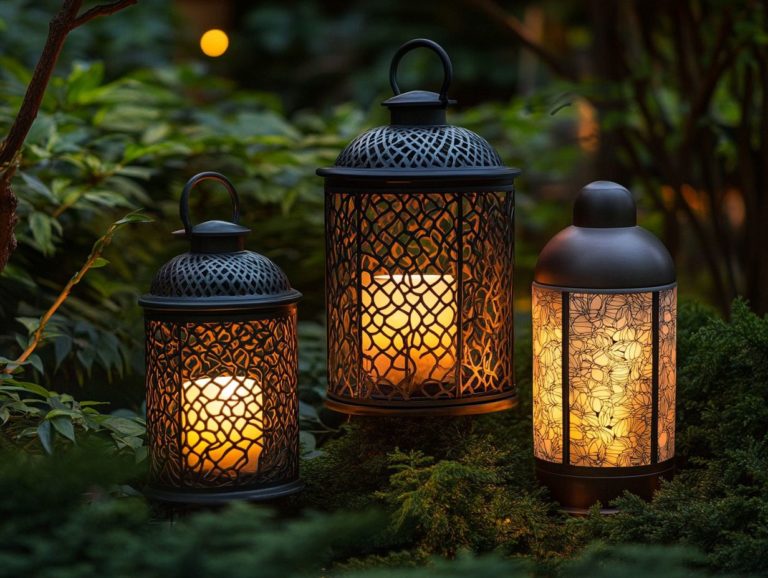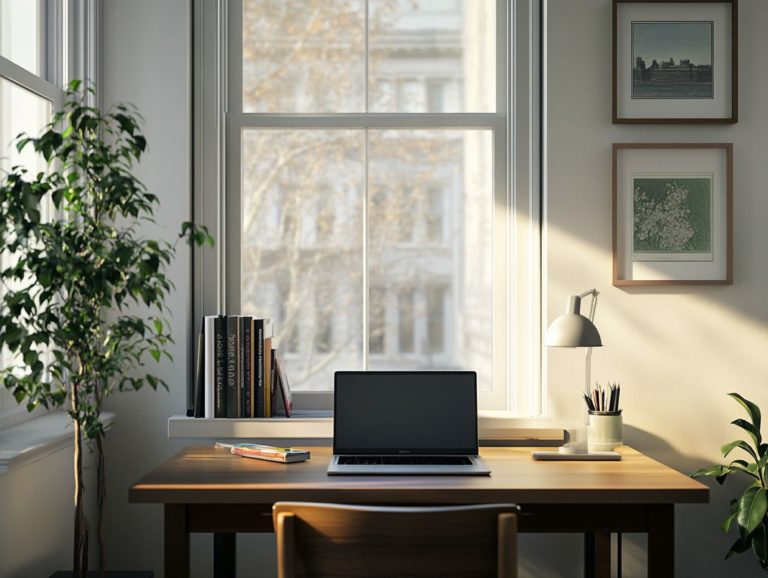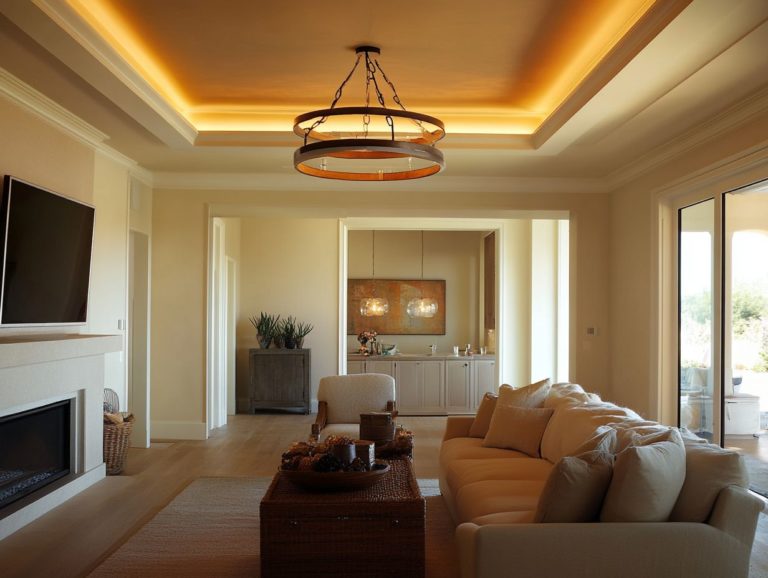“Understanding Light Placement for Different Rooms”
Proper light placement has the power to transform the ambiance and functionality of every space in your home.
Whether you re looking to create a cozy living room, a serene bedroom, or a vibrant kitchen, each area presents unique lighting needs that can significantly enhance your experience.
This article delves into the essential role of lighting in various rooms, providing insights on how to optimize both aesthetics and practicality.
Explore how making strategic lighting choices can elevate your home, turning it into not just a beautiful space but also a haven of comfort and productivity.
Contents
- Key Takeaways:
- Lighting for Living Rooms
- Lighting for Bedrooms
- Lighting for Kitchens
- Lighting for Bathrooms
- Lighting for Home Offices
- Frequently Asked Questions
- What is the importance of understanding light placement for different rooms?
- How does the placement of light affect a room?
- What are some key factors to consider when placing lights in different rooms?
- How can I determine the ideal light placement for a specific room?
- Are there any general guidelines for light placement in different rooms?
- What are some common mistakes to avoid when placing lights in different rooms?
Key Takeaways:

- Proper light placement is crucial for creating inviting, functional, and comfortable spaces in different rooms of your home.
- In living rooms, use a combination of overhead, task, and accent lighting to create a welcoming and versatile space for socializing and relaxation.
- For bedrooms, prioritize soft and warm lighting to promote a calm and cozy atmosphere while also incorporating task lighting for practical purposes.
Importance of Proper Light Placement
Proper light placement is essential for enhancing the ambiance and functionality of your space. In your home, lighting plays a pivotal role in shaping daily experiences and influences how you perceive your surroundings and feel in them.
When strategically positioned, lighting elements be it general, task, or accent lighting can elevate illumination levels, reduce glare, and create optimal environments tailored to specific activities in each room.
For example, recessed lighting offers a clean, unobtrusive appearance while effectively illuminating work areas, which can significantly boost your productivity.
On the other hand, wall sconces can infuse warmth and create an inviting atmosphere, ideal for relaxation spaces like your living room or reading nook, enhancing your overall mood.
Integrating track lighting provides the flexibility to highlight artwork or architectural features, enriching the aesthetics of your home while guiding the eye around the room.
By thoughtfully combining these different lighting types, you can craft personalized spaces that not only promote well-being but also spark creativity.
Lighting for Living Rooms
The living room serves as the heart of your home, and a carefully curated lighting design can transform it into a warm and stylish haven that reflects your personal taste while enhancing both aesthetics and energy efficiency.
This space necessitates a thoughtful blend of lighting types: general lighting for overall illumination, task lighting for reading or hobbies, and accent lighting to showcase your favorite decor or artwork.
By strategically employing fixtures like pendant lights, wall sconces, and recessed lights, you can craft an enchanting ambiance that caters to every function and mood.
Creating an Inviting and Functional Space
Creating an inviting and functional living space requires a thoughtful approach to lighting, where you balance task lighting with ambient lighting to achieve both practicality and mood.
By blending various lighting types and incorporating controls or dimmers, you can easily adjust illumination levels to fit different times of day and activities.
Embracing natural light will elevate the space, while selecting the right light colors can invoke desired emotional responses, whether it s calmness or energy. This transforms your living room into a versatile haven for relaxation and social gatherings.
To achieve this harmonious balance, consider strategically placing task lights near your favorite reading nook or kitchen counters, ensuring that specific tasks are well-lit without overwhelming the overall ambiance.
Large windows or reflective surfaces can maximize natural light, creating a vibrant atmosphere. The choice of color temperature, whether warm or cool, plays a critical role in setting the mood; cooler tones can invigorate your space while warmer hues foster a sense of coziness.
For those who love a hands-on project, experimenting with creative DIY ideas like upcycling jars into chic lamp fixtures adds a personal touch and enhances your overall aesthetic appeal.
Consider exploring different lighting options in your home and sharing your experiences to inspire others!
Lighting for Bedrooms
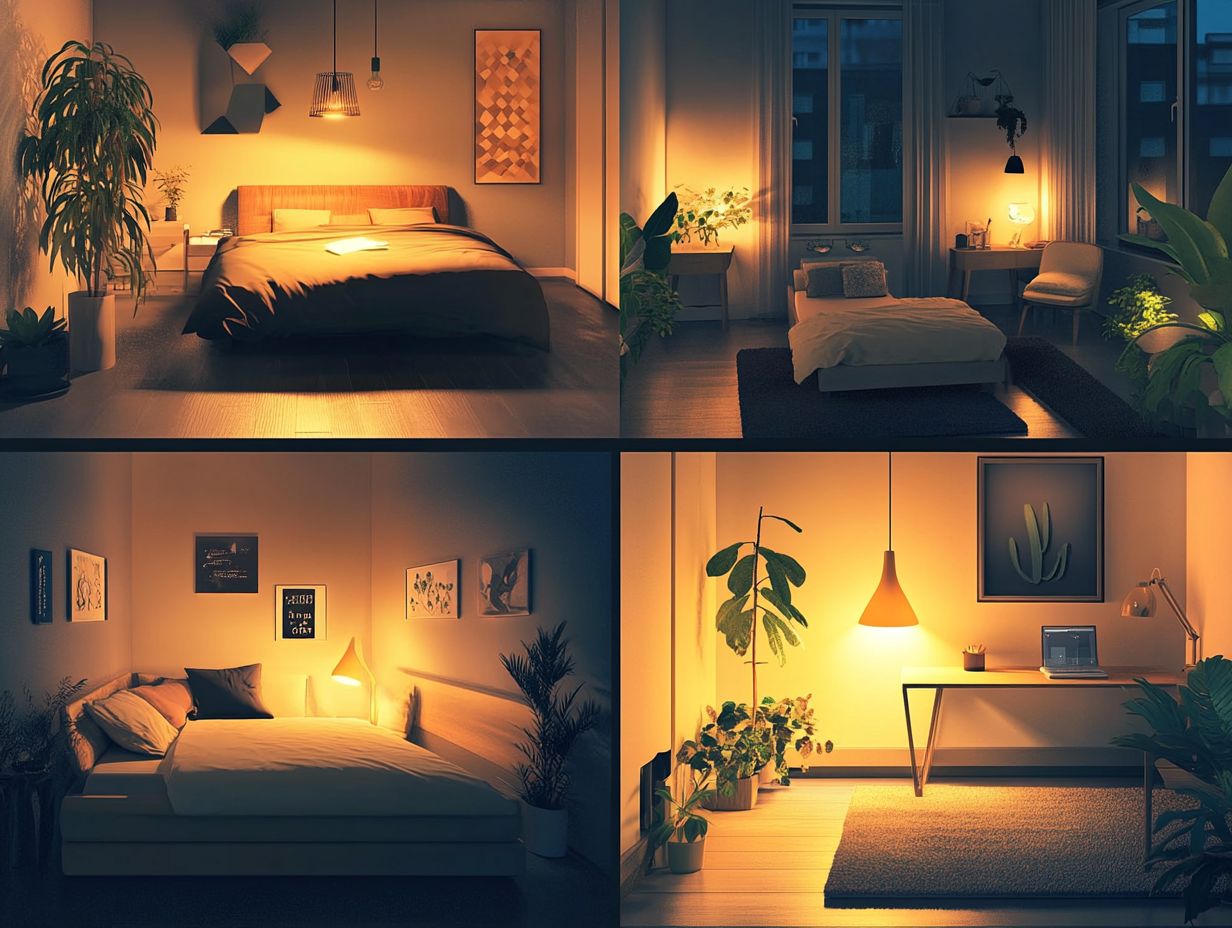
In your bedroom, a relaxing atmosphere is vital for better sleep and overall well-being. Create this by using a thoughtful lighting scheme that layers different types of lights.
The right mix of general, task, and accent lighting personalizes your space. Choose energy-efficient options like LED bulbs to create your tranquil retreat today!
Creating a Relaxing and Comfortable Atmosphere
Ambient lighting is essential for a serene environment that promotes rest. Select soft white or therapeutic light bulbs to influence the room’s vibe.
A mix of decorative and functional lighting enhances aesthetic appeal and ensures versatility for tranquil evenings and invigorating mornings.
Research shows that different types of light can impact your mood and sleep quality. A well-planned lighting strategy is crucial for your mental well-being.
Warmer tones in the evening signal your body to unwind, while cooler tones in the morning help you wake up refreshed.
Layering your lighting with bedside lamps, wall sconces, and dimmable ceiling fixtures creates a customized experience. Incorporating smart dimmers elevates adaptability, transforming your bedroom into a true sanctuary for relaxation and rejuvenation.
Lighting for Kitchens
In your kitchen, maximizing both functionality and aesthetics is essential. Effective lighting not only facilitates cooking tasks but also enhances the visual appeal of your space.
Design a lighting scheme that integrates task lighting, such as under-cabinet and recessed lights, to brighten work surfaces. Include general lighting to ensure the entire area is well-lit.
By exploring energy-efficient lighting options and selecting the right fixtures, you can create a kitchen that balances practicality with style.
Make Your Kitchen Shine with Smart Lighting Choices!
Maximizing functionality and aesthetics in your kitchen means choosing the right mix of lighting tailored to cooking and social activities. Start with ambient lighting as your foundation to set the overall mood.
Next, add task lighting track lighting and under-cabinet fixtures illuminate work areas, making food preparation safe and efficient. Don t underestimate natural light; strategic window placement brightens your kitchen and creates a warm, inviting atmosphere.
Incorporating decorative fixtures like pendant lights over your island or a stylish chandelier elevates your kitchen s design. Dimmable options allow you to adjust the ambiance for any occasion.
Remember to use energy-efficient bulbs such as LEDs. They provide brightness while saving on electricity costs.
Your well-thought-out lighting choices meet practical needs and reflect your personal style, transforming your kitchen into a harmonious blend of design and utility.
Lighting for Bathrooms

Balancing lighting for specific tasks and ambient lighting in your bathroom is essential for crafting a space that is both functional and stylish. This caters to your daily routines while ensuring safety and comfort.
When designing your lighting, prioritize lighting around mirrors and work areas. Consider using fixtures like wall sconces and recessed lights to reduce shadows and enhance visibility.
By complementing this with ambient lighting, you create an inviting atmosphere that allows for relaxation while enjoying a well-lit and aesthetically pleasing environment.
Balancing Task and Ambient Lighting
Balancing lighting for specific tasks and ambient lighting in your bathroom requires thoughtful consideration of light placement and fixture types. This ensures you achieve both functionality and aesthetics without sacrificing energy efficiency.
Task lighting should be strategically positioned to illuminate essential work areas, like around sinks and mirrors. Opt for fixtures like wall sconces and recessed lighting to accomplish this. Meanwhile, ambient lighting can soften the overall atmosphere, enhancing your bathroom’s decor while providing practical illumination for daily tasks.
For instance, installing dimmable LED fixtures gives you the versatility to adjust brightness levels according to your needs. You may desire vibrant light for makeup application or a softer glow for a relaxing bath.
Additionally, placing mirrors with integrated lighting can enhance task visibility while harmonizing with the surrounding design.
Energy-saving options such as motion sensor lights near entrances or efficient LED bulbs help reduce electricity costs and contribute to a more sustainable home environment.
Combine different types of fixtures and smart placement to create a balanced and inviting space that serves both practical and aesthetic purposes.
Lighting for Home Offices
In today s remote work environment, effective lighting in your home office is crucial for maximizing both productivity and comfort. The right lighting solutions can profoundly influence your focus and task efficiency.
A thoughtfully designed home office should seamlessly blend lighting for specific tasks, like desk lamps, with ambient lighting that evenly illuminates the space without causing glare or eye strain.
Ensure your lighting design complies with electrical safety standards. This is vital for creating a workspace that is not only functional but also enjoyable to work in.
Optimizing Productivity and Comfort
Optimizing your productivity and comfort in your home office comes down to the strategic placement of task lighting and the thoughtful selection of lighting controls that offer flexibility and adaptability.
By ensuring that your task lights are effectively positioned, illuminating work surfaces while avoiding harsh shadows, you can enhance your focus and minimize eye fatigue.
Choosing energy-efficient lighting solutions not only cuts down on electricity costs but also contributes to a more sustainable workspace.
Different types of light sources, from LED to natural daylight, can significantly impact your mood and performance. For example, warmer lights can foster a cozy atmosphere perfect for creativity, while cooler, brighter lights can boost alertness and concentration.
To maintain comfort, consider using dimmer switches or smart lighting options. This allows you to adjust brightness throughout the day based on the availability of natural light.
Experimenting with layered lighting, such as combining ambient and task lighting, can elevate the functionality of your space. Transform it into more than just a work area it becomes a true hub of inspiration.
Frequently Asked Questions
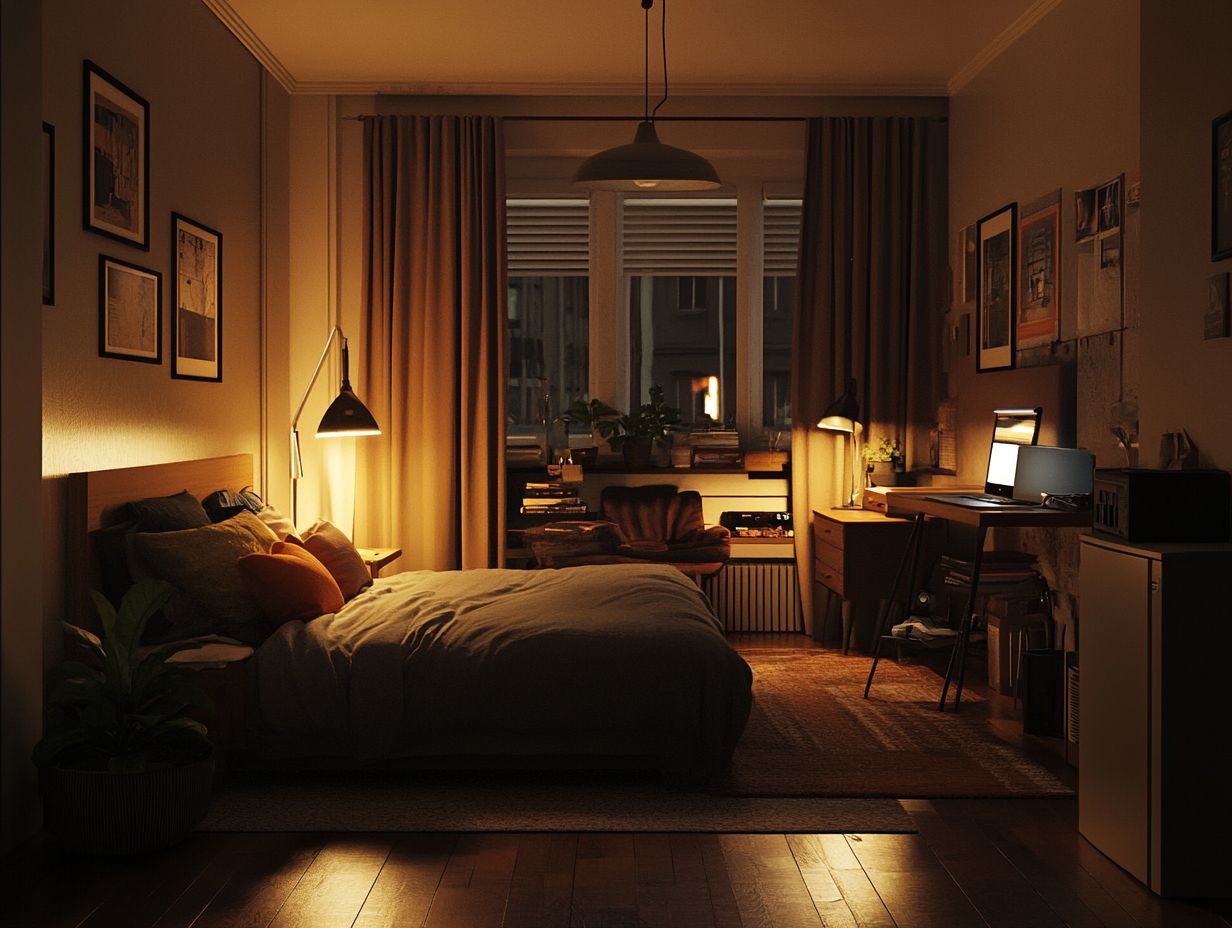
What is the importance of understanding light placement for different rooms?
Knowing how to place lights in each room can make a big difference in how functional and inviting the space feels. Properly placed lighting can enhance the room’s functionality and create a welcoming and comfortable environment.
How does the placement of light affect a room?
The placement of light greatly influences a room’s look and functionality. A well-placed pendant light can highlight a focal point while task lighting makes daily activities easier.
What are some key factors to consider when placing lights in different rooms?
Consider the room’s purpose and its natural light sources. Also, think about the arrangement of furniture, the light s color temperature, and brightness.
How can I determine the ideal light placement for a specific room?
To find the ideal light placement, think about the room’s function and layout. Researching or consulting with a professional can provide excellent ideas.
Are there any general guidelines for light placement in different rooms?
While there are no strict rules, some guidelines can help. Ensure ambient lighting is evenly spread, while task lighting focuses on specific areas.
What are some common mistakes to avoid when placing lights in different rooms?
Avoid using a single overhead light or overlooking natural light sources. Ensure that the brightness of lights suits the room’s purpose and avoid creating glare or shadows.




